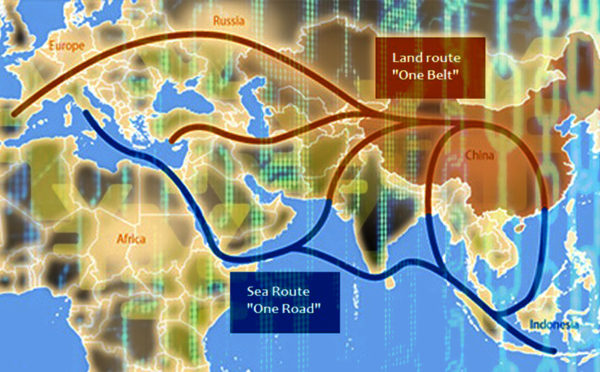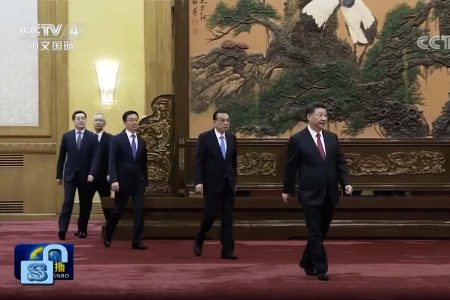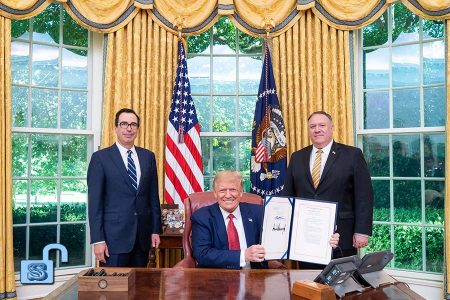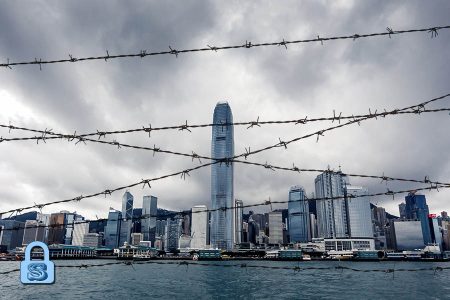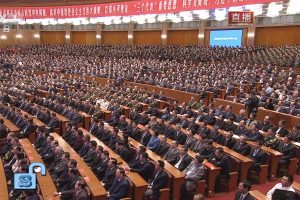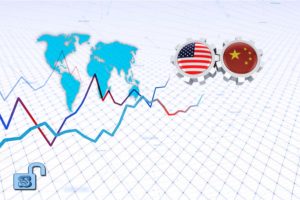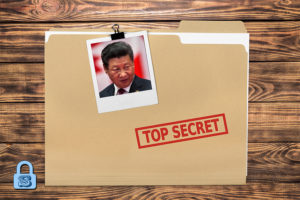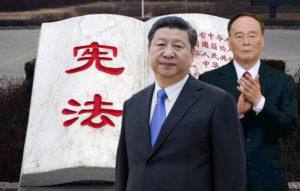◎ The CCP appears to be simultaneously resolving China’s currency oversupply issue and seeking leadership in the digital currency while threatening the dollar’s dominance through five strategies.
After months of anticipation, the China Securities Regulatory Commission announced on Feb. 9 that China would be launching its yuan-denominated crude oil futures contract on March 26. China is also pushing its 5G networks for commercialization in 2018.
Meanwhile, the Trump administration released national security and defense strategies that label China as a “revisionist power” and a competitor. Trump’s trade representative office is preparing a “big fine” on China’s intellectual property theft. New tariffs on solar panels and washing machines have been read by some observers as the beginning of a trade war with China.
The recent developments affirm the observations we made in our Dec. 10 in-depth report about China’s strategies for economic expansion in the digital age. We noted that China is seeking to internationalize the renminbi, a move that will ultimately bring China into contention with America.
In view of developments that appear to be a prelude to an upcoming Sino-U.S. trade war, we are making available an abridged version of the report.
We will continue to update this article with links to our other briefs and articles.
China’s Five Strategies for Economic Expansion in the Digital Age
By Bo Yang
The Chinese Communist Party (CCP) appears to be simultaneously resolving China’s currency oversupply issue and seeking leadership in the digital currency while threatening the dollar’s dominance through five strategies:
- The financialization of China’s big internet companies.
- China’s big internet companies building up financial networks overseas.
- Government-led integration of private and public financial systems.
- The Belt and Road Initiative (BRI) as a national-level strategy to facilitate RMB internationalization.
- Government-backed digital currency aimed at next-generation financial dominance.
In the short term, the financialization of internet firms like Alibaba and the BRI development strategy will allow China to export excess production capacity and RMB to alleviate domestic inflation.
In the long run, China’s regional control of the internet, data streams, and logistics chains, as well as the rise of digital currency and yuan-denominated gold and oil benchmarks, will allow China to seriously challenge the U.S. for the role of global financial leader.
Strategy 1: The financialization of China’s internet giants
 On Dec. 1, China Banking Regulatory Commission announced tighter regulations on the microlending industry and the banning of microlenders who operate without a proper license. About a fortnight earlier, Chinese regulators from the People’s Bank of China (PBoC) instructed provincial governments to immediately halt the approval of new internet microlenders. Mainland Chinese media then gave widespread coverage to the problems of “cash loans,” or China’s short-term, usurious, and loosely regulated small loans sector.
On Dec. 1, China Banking Regulatory Commission announced tighter regulations on the microlending industry and the banning of microlenders who operate without a proper license. About a fortnight earlier, Chinese regulators from the People’s Bank of China (PBoC) instructed provincial governments to immediately halt the approval of new internet microlenders. Mainland Chinese media then gave widespread coverage to the problems of “cash loans,” or China’s short-term, usurious, and loosely regulated small loans sector.
Yet it was the murky business of microloans which led to the financialization of China’s big internet companies—the foundation upon which RMB internationalization and even China’s future global financial dominance may be built on.
Alibaba Group, China’s largest e-commerce company, was the first big internet firm to be granted a government license to issue microloans in June 2010. Before Ali Financial, microlending companies could only operate locally. Alibaba had taken the industry country-wide. By the end of July 2017, various local governments had issued a total of 153 microloan licenses, and the industry was estimated to be worth $151 billion. Meanwhile, Alibaba’s microlending profits reached $392 million in the first half of 2017.
Microloans, however, are just a small part of Alibaba’s financial industry penetration. At the core of Alibaba’s business empire is Alipay, a third-party online and mobile payment platform. Alibaba is also involved in wealth management products, asset management, banking, insurance, securities, and social credit scoring.
Like Alibaba, other large Chinese internet companies like Tencent and Baidu have expanded into online payment, asset management, microlending, banking, insurance, investment funds, and other financial fields.
Read more:
China’s Ex-Finance Minister Warns of ‘Fairly Big’ Systemic Financial Risks
Strategy 2: Building overseas financial networks
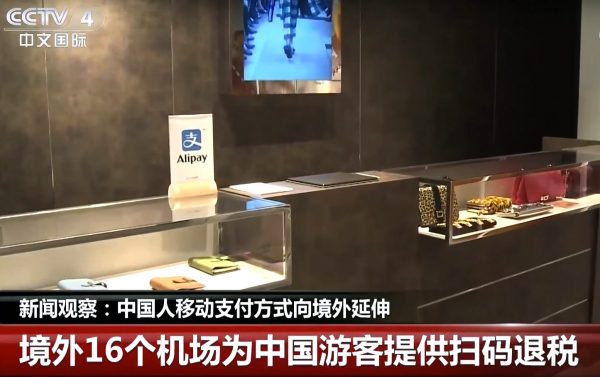 Over the past decade, many Chinese citizens have been flocking overseas as tourists and spending big. In 2016, Chinese tourist spending was $261 billion (up from $248.8 billion in 2015), and accounted for 20 percent of the total global overseas spending. The spending sprees of the Chinese tourist wave justified big Chinese internet companies’ decision to set up payment networks abroad—a move that aids the internationalization of the RMB.
Over the past decade, many Chinese citizens have been flocking overseas as tourists and spending big. In 2016, Chinese tourist spending was $261 billion (up from $248.8 billion in 2015), and accounted for 20 percent of the total global overseas spending. The spending sprees of the Chinese tourist wave justified big Chinese internet companies’ decision to set up payment networks abroad—a move that aids the internationalization of the RMB.
Taking Alibaba as an example, here are three steps that Chinese internet firms establish their overseas financial networks:
1) Provide Alipay services to Chinese tourists
At present, about 110,000 overseas merchants in major tourists cities like Australia, Taiwan, Hong Kong and Thailand accept Alipay. In May, Alibaba reached a deal with U.S. payments processor company First Data Corp. that would allow Alipay users to shop at 4 million U.S. merchants.
2) Get businesses and consumers outside China to trade on the Alibaba platform
At the 2016 G20 Summit in Hangzhou, Alibaba co-founder Jack Ma vigorously promoted the Electronic World Trade Platform (eWTP), a trading and logistics hub that helps small and medium-sized enterprises to carry out cross-border trade with few or no bureaucratic barriers.
This March, the Malaysian Digital Economic Development Organization and Alibaba opened the first eWTP “pilot zone” in Malaysia to help young entrepreneurs and small businesses in Malaysia and the Southeast Asian region to more easily participate in the global trade. In exchange, Malaysia allowed Alibaba to set up its regional logistics hub in the country.
3) Cooperate with mature local enterprises to duplicate the Alipay model
Alibaba’s financial internationalization is focused on Southeast Asia, India, and other less developed countries or regions with large populations, low credit card penetration rate, and growing mobile internet usage.
One example is Alibaba and its affiliate Ant Financial’s investment in Paytm, India’s largest e-wallet company. Alibaba and Ant own 62 percent of Paytm following a combined investment of about $700 million between 2015 to 2017. On the advice of the Alipay team, Paytm added dining, bulk buying, ride-hail, movie tickets, and other services to its payment products. According to official information from Paytm, the company has a total of 250 million subscribers as of April, second only to WeChat and Alipay.
To promote global trading platforms, Alibaba has said that it will invest $15 billion in rookie networks to create a global logistics system that will support international trade.
Read more:
Trump’s National Security Strategy a Timely Counter to China’s Expansionism
Strategy 3: Government-led integration of private and public financial systems
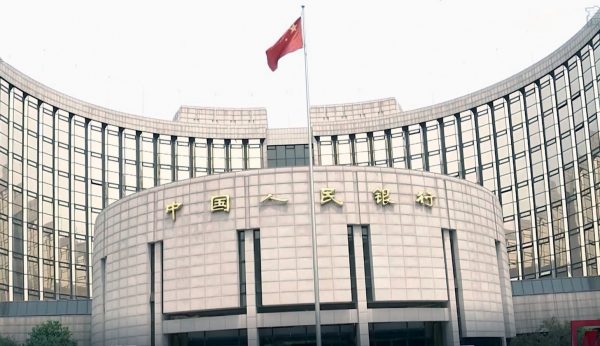 There isn’t much resistance from sovereign countries and regions to private firms like China’s internet giants building up networks for RMB internationalization. However, the lines become blurred with the integration and coordination of private companies with public entities.
There isn’t much resistance from sovereign countries and regions to private firms like China’s internet giants building up networks for RMB internationalization. However, the lines become blurred with the integration and coordination of private companies with public entities.
Integration began on July 28 when the PBoC led Alibaba’s AliPay, Tencent’s Tenpay, and 42 other financial firms to invest $303 million in the creation of China Nets Union Clearing Corporation (CNUCC), a new clearinghouse for online payment services. A week later, the PBoC issued a circular requiring all banks and online payment systems to joint the CNUCC by Oct. 15, and route all online transactions through the clearinghouse by June 30, 2018.
Under the previous model, the Chinese internet giants directly carry out transactions between individual bank accounts, a process that bypasses the central bank’s supervision. This direct connection model represents a threat to the PBoC and the mainland banking business in general because transactions are unregulated and the banks cannot charge intermediary fees. The establishment of the CNUCC gives the PBoC oversight over third-party payment transactions, and the move to place core financial data in Beijing’s hands has been greeted at home and abroad as being conducive to the prevention of capital outflow, money laundering, and other illegal financial activity.
Yet it is precisely the integration of private and public financial systems that allow the Chinese authorities to better pursue its strategy for RMB internationalization. First, Beijing now has a closed-system to collect data and coordinate the different interests and technologies of the Chinese internet companies through the CNUCC platform to facilitate RMB circulation. The CNUCC is also a financial network that helps the Chinese state and private companies align the RMB’s internationalization with the BRI national strategy. Finally, with the PBoC’s endorsement, Chinese private payment platforms will become more competitive in expanding their business overseas.
Strategy 4: Exporting RMB via the Belt and Road
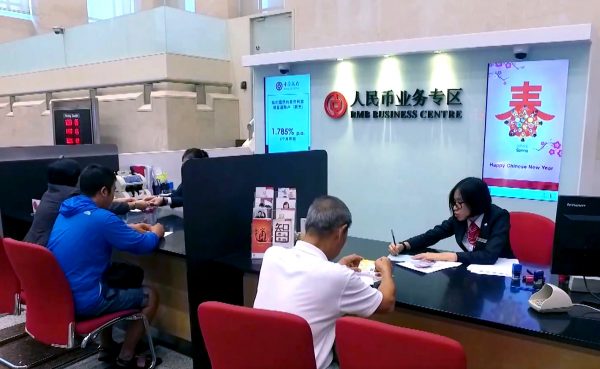 The BRI, China’s grand development strategy for the coming decades, was enshrined in the CCP constitution at the 19th Party Congress. If the Beijing can see through the BRI’s implementation, it will be a key instrument for the RMB’s internationalization and the challenge the dollar’s circulation.
The BRI, China’s grand development strategy for the coming decades, was enshrined in the CCP constitution at the 19th Party Congress. If the Beijing can see through the BRI’s implementation, it will be a key instrument for the RMB’s internationalization and the challenge the dollar’s circulation.
In 2017, Qiao Liang, a retired People’s Liberation Army air force major general and author of bestselling book “Unrestricted Warfare,” wrote in his blog that the BRI is aimed at solving two major problems faced by China—severe overcapacity and an excessive RMB stockpile. Qiao noted that China would soon drown in an RMB “flood” unless Beijing finds a way to export the currency.
Beijing had earlier tried to solve the two problems that Qiao identified with a northeast Asia free trade area with $20 trillion comprising China, Japan, South Korea, Hong Kong, Macao, and Taiwan. Negotiations broke down, however, after tensions flared in the region over the Senkaku Islands and Scarborough Shoal in early 2012. Three years later, Beijing made some headway towards resolving the China’s problems with the creation of the Asian Infrastructure Investment Bank.
The BRI represents Beijing’s long-term plan to reduce its production overcapacity and export the RMB. The BRI’s maritime route will connect northeast and southeast Asia, creating a $30 trillion eastern free trade region. The overland route will connect west, south, and north Asia with the five central Asian countries, forming a trading area larger than the eurozone and North America combined. The entire Asian free trade region could be worth $50 trillion; in contrast, the eurozone is valued at $27 trillion and the North American zone at $25 trillion.
The settlement of trade in the Asian free trade zone fostered by the BRI, whether using the renminbi or using a yuan-backed Asian dollar, will greatly weaken the global circulation of the U.S. dollar.
Read more:
Decoding the 19th Congress Report: China Plans to Surpass the US in 2050
China Could Get a Fifth Vice Premier
Strategy 5: Global financial dominance through government-backed digital currency
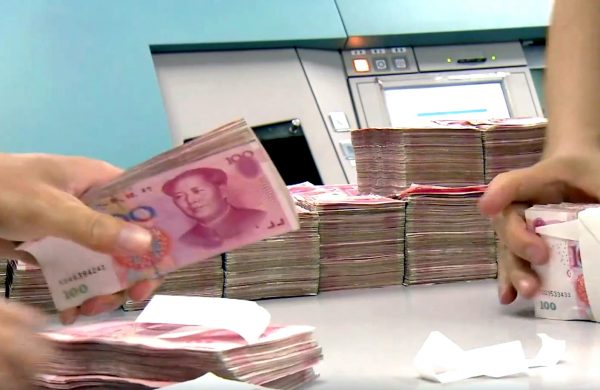 In mid-September, Chinese authorities announced the closure of three major cryptocurrency exchanges, including Bitcoin. These exchanges were to phase out their digital assets and RMB exchanges by Oct. 31.
In mid-September, Chinese authorities announced the closure of three major cryptocurrency exchanges, including Bitcoin. These exchanges were to phase out their digital assets and RMB exchanges by Oct. 31.
Beijing, however, isn’t opposed to digital currency. Last December, the PBoC completed testing of a blockchain-backed digital currency. Then about a month after shutting down foreign virtual currency exchanges, Yao Qian, the director-general of the PBoC’s Institute of Digital Money, announced the central bank’s completion of testing on algorithms required for digital currency supply. On Nov. 4, the Digital Finance Research Center of Peking University held its second annual conference on digital financing, and Yao said then that legal digital currency would be the cornerstone of the digital economy. In a 2016 paper, Yao envisions a digital RMB controlled by the PBoC that is part cryptocurrency and part physical cash.
Beijing appears to have already taken steps to ensure the viability of using the RMB or its digitized version as a global currency. In April 2016, the Shanghai Gold Exchange, the world’s largest physical bullion exchange, launched a yuan-denominated gold benchmark. This July, the Shanghai Futures Exchange and its affiliated Shanghai International Energy Exchange Center completed testing of trading crude oil futures contracts priced in RMB, and the exchange is set to be officially launched at the end of the year. Being able to exchange RMB for dollar-pegged commodities like oil and gold will facilitate the internationalization of the RMB and give consumers confidence in adopting the RMB in physical or digital form.
The reason for why China is working on its own digital currency while clamping down on those in existence is perhaps best explained by retired general Qiao Liang. Qiao wrote in his blog that the internet’s development would cause a de-monetization effect, and in the future, the widespread adoption of cryptocurrencies like Bitcoin will mean that people don’t have to rely on sovereign credit. In other words, those who control the issuance, usage, return channels and user groups of digital currency in a world where the dollar and the RMB have diminished in value will gain financial dominance.
Chinese internet giants are already well-positioned to dominate a digital economy. Jack Ma has repeatedly said in speeches that Alibaba’s future business will revolve around the control of streams of data—the new “natural resource” Indeed, data is poised to overtake currency as the new capital in an environment where new technologies like big data, mobile internet, and the Internet of Things take center stage. And China’s internet companies like Alibaba and WeChat already have in place fully integrated e-commerce, logistics, and social media systems. Combined with an immense manufacturing capacity, China is in a prime position to be a leading player in the future financial world.
Read more:
Decoding China’s Plan to Launch Crude Oil Futures
How to Read China’s Crackdown on Cryptocurrency Trading
Conclusion
The digitization of China’s economy, as well as the development of big data, artificial intelligence and internet technology, are part of the CCP’s top-level strategy for making China a future global financial leader. China’s large population and vast markets allow for rigorous testing and rapid advancement of new technologies. And China’s promotion of internet technology and mobile payment platforms abroad has led to the creation of a multinational financial network channel that will be more amenable to adopting the RMB or its digital variant.
To facilitate the RMB’s internationalization, Beijing has created yuan-denominated gold and oil exchanges and is promoting the BRI. With the CCP being able to utilize the power of the state to push digital currency research and development, China is in contention to become the next global financial leader and threaten the dollar’s position as a global reserve currency.
